
The MaloideaeC.Weber was the apple subfamily, a grouping used by some taxonomists within the rose family, Rosaceae. Recent molecular phylogenetic evidence has shown that the traditional Spiraeoideae and Amygdaloideae form part of the same clade as the traditional Maloideae, and the correct name for this group is Amygdaloideae. Earlier circumscriptions of Maloideae are more-or-less equivalent to subtribe Malinae or to tribe Maleae. The group includes a number of plants bearing commercially important fruits, such as apples and pears, while others are cultivated as ornamentals.

Stewartia is a genus of 8-20 species of flowering plants in the family Theaceae, related to Camellia. Most of the species are native to eastern Asia in China, Japan, Korea, Laos, Myanmar, Thailand, and Vietnam, with two in southeast North America, from Virginia and Kentucky south to Florida and Louisiana.

Malus sieversii is a wild apple native to the mountains of Central Asia in southern Kazakhstan. It has recently been shown to be the primary ancestor of most cultivars of the domesticated apple. It was first described as Pyrus sieversii due to its similarities with pears in 1833 by Carl Friedrich von Ledebour, a German naturalist who saw them growing in the Altai Mountains.
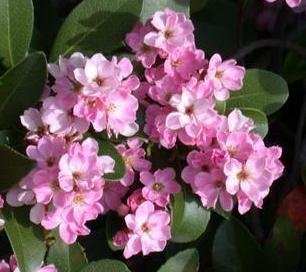
Rhaphiolepis indica, the Indian hawthorn, India hawthorn or Hong Kong hawthorn is an evergreen shrub in the family Rosaceae.

Dillenia indica, commonly known as elephant apple or ou tenga, is a species of Dillenia native to China, India, and tropical Asia. It is found in stony river banks.

Sorbus hupehensis, also known as Hupeh rowan or Hubei rowan, is a species of rowan native to central and western China. It is found between Qinghai and Gansu in the west, Yunnan in the south, Jiangxi in the southeast, and Shandong in the east.
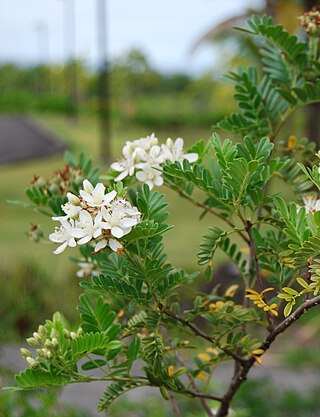
Osteomeles is a genus of plants in the rose family, Rosaceae. They are shrubs native to eastern Asia, with compound leaves, opposite leaf arrangement, and small pome fruit. The fruits of all species in this genus are edible.

Amelanchier asiatica, commonly known as Korean juneberry or Asian serviceberry, is a species in the genus Amelanchier, native to China, Japan, and Korea. It is a shrub or small tree, growing to about 12 metres (39 ft) tall.
Osteomeles subrotunda is a species of plant native to China and the Ryukyu islands of Japan. It has edible fruits that can be eaten raw. The fruit has a sweet flavor. It is grown as an ornamental plant. It is also used in bonsai.

Rubus parvifolius, called Japanese bramble, or Australian raspberry in the United States or native raspberry in Australia is a species of plant in the rose family. It is a scrambling shrub native to eastern Asia and Australia. It has also become naturalized in a few scattered locations in the United States.
Crataegus altaica is a species of hawthorn. It is sometimes considered to be a synonym of C. wattiana. Crataegus altaica var. villosa is considered to be a synonym of Crataegus maximowiczii.

Malus baccata is an Asian species of apple known by the common names Siberian crab apple, Siberian crab, Manchurian crab apple and Chinese crab apple. It is native to many parts of Asia, but is also grown elsewhere as an ornamental tree and for rootstock. It is used for bonsai. It bears plentiful, fragrant, white flowers and edible red to yellow fruit of about 1 cm diameter.

Malus doumeri is a species in the genus Malus in the family Rosaceae, that resembles Docynia and has been placed in that genus in the past. It is native to temperate and tropical Asia. The fruit is edible.
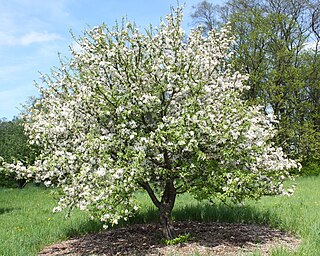
Malus prunifolia is a species of crabapple tree known by the common names plumleaf crab apple, plum-leaved apple, pear-leaf crabapple, Chinese apple and Chinese crabapple. It is native to China, and is grown elsewhere for use as an ornamental tree or as rootstock. It reaches from between 3 and 8 meters tall and bears white flowers and yellow or red fruit.

Malus rockii is a crabapple species in the family Rosaceae. It is native to China and Bhutan.
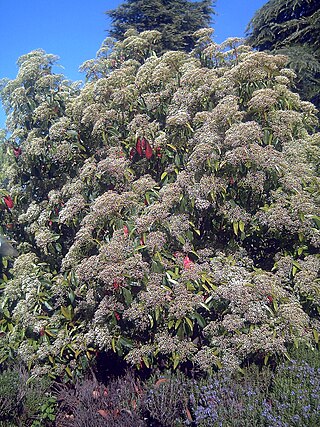
Photinia serratifolia, commonly called Taiwanese photinia or Chinese photinia is a flowering shrub or tree in the flowering plants family Rosaceae, found in mixed forests of China, Taiwan, Japan, the Philippines, Indonesia, and India.
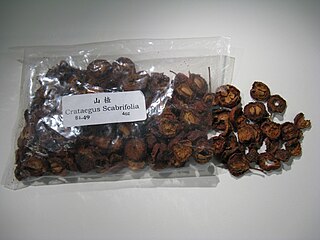
Crataegus scabrifolia is a hawthorn from China that grows at altitudes between 1500 and 3000 m in areas with high rainfall. It is usually a large shrub or small tree, and usually without thorns. The edible fruit are large for a hawthorn, up to 2.5 cm in diameter, red or yellow, and are sold in local markets. The tree is apparently not cultivated outside China.

The Maleae are the apple tribe in the rose family, Rosaceae. The group includes a number of plants bearing commercially important fruits, such as apples and pears, while others are cultivated as ornamentals. Older taxonomies separated some of this group as tribe Crataegeae, as the Cydonia group, or some genera were placed in family Quillajaceae.

Malinae is the name for the apple subtribe in the rose family, Rosaceae. This name is required by the International Code of Nomenclature for algae, fungi, and plants, which came into force in 2011 for any group at the subtribe rank that includes the genus Malus but not either of the genera Rosa or Amygdalus. The group includes a number of plants bearing commercially important fruits, such as apples and pears, while others are cultivated as ornamentals.
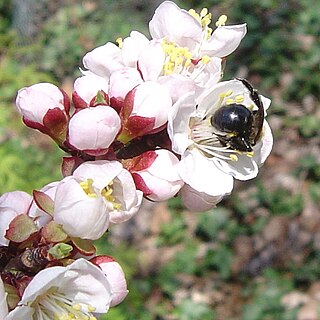
Prunus mandshurica, also called Manchurian apricot and scout apricot, is a tree in the genus Prunus.

















